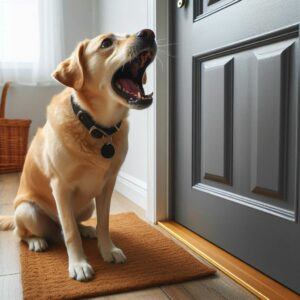Understanding the Causes & Solutions for Your Furry Friends

Separation anxiety in pets is more common than you might think. Dogs and cats, and sometimes birds, can develop this condition when they become distressed due to being separated from their primary caregivers. The pets exhibit behaviors that indicate their discomfort, such as excessive barking, whining, or even destructive actions like chewing on furniture.
- Separation anxiety isn’t restricted to specific species, but dogs are the most frequently affected. It can also affect birds and cats, however; the symptoms aren’t often as evident. For instance, birds might pluck out their feathers, while cats might become extremely vocal or hide all the time. Identifying these indicators is the first step toward making your pet feel more comfortable.
- Anxiety related to separation can be caused by several things. Anxiety can be brought on by significant changes in the pet’s life, such as a move to a new home or adjustments to the family’s dynamics. Sensitive pets may become agitated by even seemingly small changes, such as a change in daily habits. Pets that have experienced traumatic events, like being abandoned or rehomed multiple times, are also more susceptible.
- A few real-life examples can help illustrate the wide range of behaviors associated with separation anxiety. I once encountered a case where a dog chewed through drywall when left alone. Another cat I knew would incessantly meow and scratch at the door the moment its owner left the house. These behaviors aren’t just frustrating—they’re cries for help. The first step to helping your pet adapt better is to have an understanding of what they are going through.
Recognizing the Signs of Separation Anxiety
Understanding the symptoms of separation anxiety can significantly impact your pet’s health. Behavioral signs are often the first indicators. Pets might start destroying furniture, scratching doors, or howling non-stop. More than just bad behavior, your pet is using these behaviors to express their worry and anxiety.

- There may also be physical signs that indicate your pet is having difficulties. Excessive drooling, trembling, or even going to the bathroom inside the house can be signs your pet is feeling anxious without you around.
- Assessing the severity of your pet’s anxiety is crucial. Mild cases might involve some pacing or whining. More severe cases could involve attempts to escape or self-harm. Understand the range so you can address the issue appropriately.
- There are many false beliefs regarding separation anxiety. One widespread misconception is that when left alone, pets behave spitefully. In reality, these behaviors are driven by panic and fear, not by any form of revenge. Understanding the differences facilitates the application of effective solutions and an empathetic approach to the problem.
Effective Strategies for Managing Separation Anxiety
- A combination of tolerance, teaching, and occasionally expert assistance is needed to manage separation anxiety. Techniques for behavior modification and consistent instruction can have a big impact. Gradually get your pet used to being alone by starting with short absences. Pair these with positive experiences like treats or favorite toys to create a sense of comfort when you’re not around.
- Creating a safe and comforting environment is key. Set aside a comfortable area with their toys, bed, and maybe some things that smell like you. Some pets find comfort in listening to soothing music or white noise, which can mimic your presence and reduce stress.
- Calming products and medications can also be helpful. In severe cases, options such as anxiety wraps, pheromone diffusers, or even vet-prescribed medicine can help reduce symptoms. Always consult your veterinarian before starting any medication to ensure it’s safe for your pet.
- Expert assistance can result in tactics designed to meet your pet’s demands. Experts in animal behavior and veterinarians can collaborate to create a comprehensive management plan that covers everything from customized instruction to potential treatment alternatives.
Preventing Separation Anxiety in Pets
You and your pet can avoid a great deal of stress in the future by taking proactive measures to prevent separation anxiety from the start. It is essential to start socializing and training your pet while it is young. When your pet is young or even a new pet in your household, expose them to various people, places, and experiences. This boosts self-assurance and decreases loneliness-related feelings of insecurity when alone.
- The foundation of a stress-free atmosphere is routine and consistency. Playtime, strolling, and feeding should all take place at the same times every day. This dependable schedule lessens anxiety and gives your pet a sense of security.
- Gradual desensitization to being alone is an effective preventive measure. Start by leaving your pet alone for short periods, slowly increasing the duration. Pair these moments with positive reinforcements like treats or interactive toys. This way, your pet associates alone time with good things.
- For new pet owners, a few tips can make a big difference. Don’t make a big deal out of it when leaving or coming home. This lessens the anxiety triggers and keeps the leaving and return quiet. When you’re home, ensure your pet gets plenty of exercise and mental stimulation to prevent boredom and pent-up energy when you’re away.
If you have any questions, personal experiences or tips to share, I’d love your feedback. Please make comments below. Thanks for joining me on this journey regarding separation anxiety in pets!
–Janice–

This article does a great job outlining the causes, symptoms, and solutions for managing separation anxiety in pets. The examples given, like the dog that chewed through drywall or the cat that meowed incessantly, illustrate how severe the effects of anxiety can be. The recommendation to start with short absences and pair them with positive experiences seems practical and effective. I’m curious, though—how long might it take for these gradual steps to start showing results? Is there a typical timeframe for pets to adjust, or does it vary significantly based on the individual pet’s history and personality?
Thank you, JR
It does vary significantly based upon the individual pet’s history and personality. It takes time and patience, and each animal is different, but if you follow the recommendations, it will help tremendously, and you will gradually begin to experience changes. It took my cat 2-3 weeks after we brought her home from the shelter before she would come out from under the bed (except to eat and relieve herself), but she finally did, which is so comforting. She’s now a happy kitty. We just left her to decide when it was best for her to come out. She was found at the ripe ole age of 1-2 years old, with a litter of kittens. She was in the shelter 8 months before we came along and gave her a good home.
Thanks for your question and input about the article.